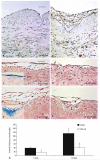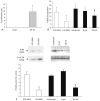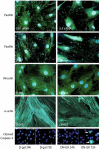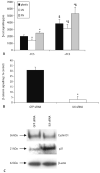Regulation of cell-matrix contacts and beta-catenin signaling in VSMC by integrin-linked kinase: implications for intimal thickening
- PMID: 18080083
- PMCID: PMC2853711
- DOI: 10.1007/s00395-007-0693-9
Regulation of cell-matrix contacts and beta-catenin signaling in VSMC by integrin-linked kinase: implications for intimal thickening
Abstract
Vascular smooth muscle cell (VSMC) proliferation and migration is responsible for intimal thickening that occurs in restenosis and atherosclerosis. Integrin-linked kinase (ILK) is a serine/threonine protein kinase implicated in signaling pathways involved in cell proliferation and migration. We studied the involvement of ILK in intimal thickening. ILK expression was significantly increased in two models of intimal thickening: balloon-injured rat carotid arteries and human saphenous vein organ cultures. Over-expression of a dominant negative ILK (DN-ILK) significantly reduced intimal thickening by approximately 50% in human saphenous vein organ cultures, demonstrating an important role in intimal thickening. ILK protein and activity was reduced on laminin and up-regulated on fibronectin, indicating ILK protein expression is modulated by extracellular matrix composition. Inhibition of ILK by siRNA knockdown and DN-ILK significantly decreased VSMC proliferation and migration while wild type ILK significantly increased proliferation and migration on laminin, confirming an essential role of ILK in both processes. Localization of paxillin and vinculin and protein levels of FAK and phospho-FAK indicated that inhibition of ILK reduced focal adhesion formation. Additionally, inhibition of ILK significantly attenuated the presence of the cell-cell complex proteins N-cadherin and beta-catenin, and beta-catenin signaling. We therefore suggest ILK modulates VSMC proliferation and migration at least in part by acting as a molecular scaffold in focal adhesions as well as modulating the stability of cell-cell contact proteins and beta-catenin signaling. In summary, ILK plays an important role in intimal thickening by modulating VSMC proliferation and migration via regulation of cell-matrix and cell-cell contacts and beta-catenin signaling.
Figures








Similar articles
-
ADAMTS-7 mediates vascular smooth muscle cell migration and neointima formation in balloon-injured rat arteries.Circ Res. 2009 Mar 13;104(5):688-98. doi: 10.1161/CIRCRESAHA.108.188425. Epub 2009 Jan 22. Circ Res. 2009. PMID: 19168437
-
Integrin-linked kinase in the vascular smooth muscle cell response to injury.Am J Pathol. 2008 Jul;173(1):278-88. doi: 10.2353/ajpath.2008.071046. Epub 2008 Jun 5. Am J Pathol. 2008. PMID: 18535176 Free PMC article.
-
Inhibition of N-cadherin retards smooth muscle cell migration and intimal thickening via induction of apoptosis.J Vasc Surg. 2010 Nov;52(5):1301-9. doi: 10.1016/j.jvs.2010.05.096. Epub 2010 Jul 13. J Vasc Surg. 2010. PMID: 20630685 Free PMC article.
-
Integrin linked kinase (ILK) expression and function in vascular smooth muscle cells.Cell Adh Migr. 2009 Apr-Jun;3(2):174-6. doi: 10.4161/cam.3.2.7374. Epub 2009 Apr 10. Cell Adh Migr. 2009. PMID: 19262169 Free PMC article. Review.
-
Role of smooth muscle cells in coronary artery bypass grafting failure.Cardiovasc Res. 2018 Mar 15;114(4):601-610. doi: 10.1093/cvr/cvy021. Cardiovasc Res. 2018. PMID: 29373656 Free PMC article. Review.
Cited by
-
BMP promotes motility and represses growth of smooth muscle cells by activation of tandem Wnt pathways.J Cell Biol. 2011 Jan 10;192(1):171-88. doi: 10.1083/jcb.201008060. J Cell Biol. 2011. PMID: 21220513 Free PMC article.
-
A pseudotyped adenovirus serotype 5 vector with serotype 49 fiber knob is an effective vector for vaccine and gene therapy applications.Mol Ther Methods Clin Dev. 2024 Jul 30;32(3):101308. doi: 10.1016/j.omtm.2024.101308. eCollection 2024 Sep 12. Mol Ther Methods Clin Dev. 2024. PMID: 39206304 Free PMC article.
-
Molecular mechanisms of voiding dysfunction in a novel mouse model of acute urinary retention.FASEB J. 2021 Apr;35(4):e21447. doi: 10.1096/fj.202002415R. FASEB J. 2021. PMID: 33742688 Free PMC article.
-
Thyroxine Induces Acute Relaxation of Rat Skeletal Muscle Arteries via Integrin αvβ3, ERK1/2 and Integrin-Linked Kinase.Front Physiol. 2021 Sep 14;12:726354. doi: 10.3389/fphys.2021.726354. eCollection 2021. Front Physiol. 2021. PMID: 34594239 Free PMC article.
-
ß-Catenin is markedly induced in a murine model of an arteriovenous fistula: the effect of metalloproteinase inhibition.Am J Physiol Renal Physiol. 2010 Dec;299(6):F1270-7. doi: 10.1152/ajprenal.00488.2010. Epub 2010 Sep 29. Am J Physiol Renal Physiol. 2010. PMID: 20881035 Free PMC article.
References
-
- Bar H, Wende P, Watson L, Denger S, Van Eys G, Kreuzer J, Jahn L. Smoothelin is an indicator of reversible phenotype modulation of smooth muscle cells in balloon-injured rat carotid arteries. Basic Res Cardiol. 2002;97:9–16. - PubMed
-
- Chen X, Gumbiner BM. Cross-talk between different adhesion molecules. Curr Opin Cell Biol. 2006;18:572–578. - PubMed
-
- Dietrich T, Perlitz C, Licha K, Stawowy P, Atrott K, Tachezy M, Meyborg H, Stocker C, Grafe M, Fleck E, Schirner M, Graf K. ED-B fibronectin (ED-B) can be targeted using a novel single chain antibody conjugate and is associated with macrophage accumulation in atherosclerotic lesions. Basic Res Cardiol. 2007;102:298–307. - PubMed
Publication types
MeSH terms
Substances
Grants and funding
LinkOut - more resources
Full Text Sources
Research Materials
Miscellaneous

